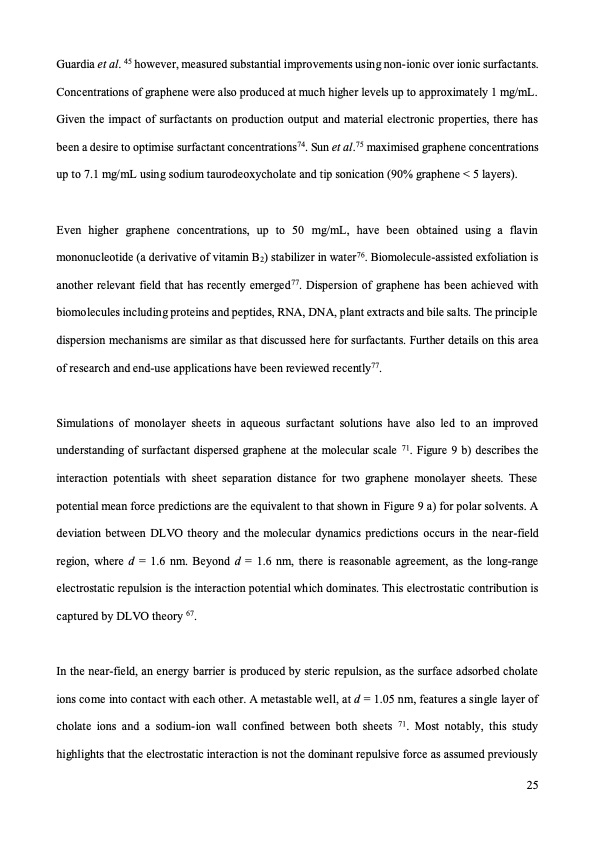PDF Publication Title:
Text from PDF Page: 025
Guardia et al. 45 however, measured substantial improvements using non-ionic over ionic surfactants. Concentrations of graphene were also produced at much higher levels up to approximately 1 mg/mL. Given the impact of surfactants on production output and material electronic properties, there has been a desire to optimise surfactant concentrations74. Sun et al.75 maximised graphene concentrations up to 7.1 mg/mL using sodium taurodeoxycholate and tip sonication (90% graphene < 5 layers). Even higher graphene concentrations, up to 50 mg/mL, have been obtained using a flavin mononucleotide (a derivative of vitamin B2) stabilizer in water76. Biomolecule-assisted exfoliation is another relevant field that has recently emerged77. Dispersion of graphene has been achieved with biomolecules including proteins and peptides, RNA, DNA, plant extracts and bile salts. The principle dispersion mechanisms are similar as that discussed here for surfactants. Further details on this area of research and end-use applications have been reviewed recently77. Simulations of monolayer sheets in aqueous surfactant solutions have also led to an improved understanding of surfactant dispersed graphene at the molecular scale 71. Figure 9 b) describes the interaction potentials with sheet separation distance for two graphene monolayer sheets. These potential mean force predictions are the equivalent to that shown in Figure 9 a) for polar solvents. A deviation between DLVO theory and the molecular dynamics predictions occurs in the near-field region, where d = 1.6 nm. Beyond d = 1.6 nm, there is reasonable agreement, as the long-range electrostatic repulsion is the interaction potential which dominates. This electrostatic contribution is captured by DLVO theory 67. In the near-field, an energy barrier is produced by steric repulsion, as the surface adsorbed cholate ions come into contact with each other. A metastable well, at d = 1.05 nm, features a single layer of cholate ions and a sodium-ion wall confined between both sheets 71. Most notably, this study highlights that the electrostatic interaction is not the dominant repulsive force as assumed previously 25PDF Image | graphene production via nonoxidizing liquid exfoliation

PDF Search Title:
graphene production via nonoxidizing liquid exfoliationOriginal File Name Searched:
Graphene-R2-review.pdfDIY PDF Search: Google It | Yahoo | Bing
Salgenx Redox Flow Battery Technology: Power up your energy storage game with Salgenx Salt Water Battery. With its advanced technology, the flow battery provides reliable, scalable, and sustainable energy storage for utility-scale projects. Upgrade to a Salgenx flow battery today and take control of your energy future.
CONTACT TEL: 608-238-6001 Email: greg@infinityturbine.com (Standard Web Page)